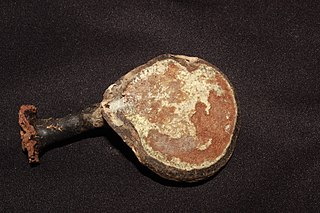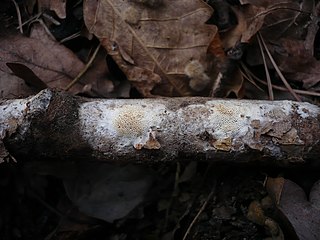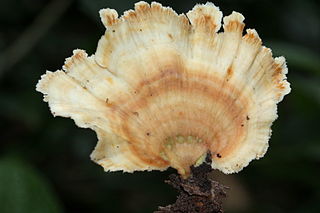
Junghuhnia is a genus of crust fungi in the family Steccherinaceae. It was circumscribed by Czech mycologist August Carl Joseph Corda in 1842. The generic name honours German-Dutch botanist Franz Wilhelm Junghuhn.

Ganoderma orbiforme is a species of polypore fungus that is widespread across southeast Asia. It is a plant pathogen that causes basal stem rot, a disease of the African oil palm. The fungus was first described scientifically in 1838 by Elias Magnus Fries from collections made in Guinea. Leif Ryvarden transferred it to the genus Ganoderma in 2000. In addition to its type locality, the fungus has also been collected from the Bonin Islands in the Pacific, and from Venezuela and Puerto Rico. Microsatellite markers have been developed to help identify the fungus and study the genetic diversity of G. orbiforme.

Oxyporus is a genus of polypore fungi in the family Schizoporaceae. An individual family Oxyporaceae was described for the genus. A number of species in this genus are plant pathogens, causing a white rot. The genus is widely distributed.

Ceriporiopsis is a genus of fungi in the family Phanerochaetaceae. The genus is widely distributed, and, according to a 2008 estimate, contains about 25 species. Ceriporiopsis was circumscribed in 1963 by Polish mycologist Stanislaw Domanski. The genus is a wastebasket taxon, containing "species that share common macroscopic and microscopic characteristics, but are not necessarily related." Ceriporiopsis species are crust fungi that cause a white rot. They have a monomitic hyphal system, containing only generative hyphae, and these hyphae have clamp connections.

Ceriporia is a widely distributed genus of crust fungi.
Australicium is a genus of two species of crust fungi in the family Phanerochaetaceae. The genus was circumscribed by mycologists Kurt Hjortstam and Leif Ryvarden in 2002 to contain the type species, A. singulare, which is found in New Zealand. The Venezuelan species A. cylindrosporum was added to the genus in 2005.

Antrodiella is a genus of fungi in the family Steccherinaceae of the order Polyporales.

Diplomitoporus is a genus of fungi in the family Polyporaceae. The Dictionary of the Fungi estimated the widespread genus to contain 11 species; since then, the genus has grown with the additional of several newly described species, and some transfers from other genera. Diplomitoporus has been described as a wastebasket taxon, containing "species that share common macroscopic and microscopic characteristics, but are not necessarily related."

Flabellophora is a genus of poroid fungi in the family Steccherinaceae. The genus was circumscribed by New Zealand-based mycologist Gordon Herriot Cunningham 1965. Most species in the genus were described by E. J. H. Corner in 1987.

Nigroporus is a genus of poroid fungi in the family Steccherinaceae. The genus was circumscribed by American mycologist William Alphonso Murrill in 1905. Nigroporus has a pantropical distribution. The genus name combines the Latin word niger ("black") with the Ancient Greek word πόρος ("pore").

Skeletocutis is a genus of about 40 species of poroid fungi in the family Polyporaceae. The genus has a cosmopolitan distribution, although most species are found in the Northern Hemisphere. Skeletocutis causes a white rot in a diverse array of woody substrates. Their fruit bodies grow as a crust on the surface of the decaying wood. Sometimes the edges of the crust are turned outward to form rudimentary bracket-like caps.
Tinctoporellus is a genus of fungi in the family Polyporaceae. Species in the genus produce crust-like fruit bodies with pore-containing surfaces. The type species, T. epimiltinus, grows on the wood of angiosperms and is widespread in distribution. Tinctoporellus was circumscribed by Norwegian mycologist Leif Ryvarden in 1979. He suggested that Antrodia was closely related based on morphological similarities.
Skeletocutis microcarpa is a species of poroid fungus in the family Polyporaceae that is found in Venezuela. It was reported as a new species by mycologists Leif Ryvarden and Teresa Iturriaga. The type collection was made in January 1997, in Yutajé, where it was found growing on the bark of a living tree. The fruit bodies of this fungus are in the form of small brown caps measuring up to 8 mm wide and long by 4 mm thick. Its spores are smooth, ellipsoid, hyaline, and measure 3–3.3 by 2 μm.
Nigroporus macroporus is a species of poroid fungus in the family Steccherinaceae. It was described as new to science in 2003 by mycologists Leif Ryvarden and Teresa Iturriaga. Found in Venezuela and Brazil, it is a wood-decay fungus that causes a white rot in the hardwood Dimorphandra macrostachya.
Metuloidea cinnamomea is a species of tooth fungus in the family Steccherinaceae. Found in the Andes region of Venezuela, it was initially described in 2010 by Teresa Iturriaga and Leif Ryvarden as a species of Antrodiella. Otto Miettinen and Ryvarden transferred it to the newly created genus Metuloidea in 2016.
Diplomitoporus microsporus is a species of poroid fungus in the family Polyporaceae. Found in the Andes region of Venezuela, it was described as a new species in 2010 by mycologists Teresa Iturriaga and Leif Ryvarden.
Junghuhnia globospora is a species of poroid fungus in the family Steccherinaceae. Found in the Andes region of Venezuela, it was described as a new species in 2010 by mycologists Teresa Iturriaga and Leif Ryvarden.
Trulla dentipora is a neotropical polypore fungus in the family Steccherinaceae, and the type species of the genus Trulla. Characteristics of this species are the irregularly shaped pores with jagged or teeth-like edges, and the sausage-shaped spores. Found in Venezuela, the fungus was originally described by mycologists Leif Ryvarden and Teresa Iturriaga in 2004 as a species of Antrodiella. The type was collected in Henri Pittier National Park, where it was found growing on a hardwood log. Ryvarden and Otto Miettinen transferred the fungus to the newly created Trulla in 2016.
Skeletocutis polyporicola is a species of poroid crust fungus in the family Polyporaceae that is found in South America. It was described as a new species in 2011 by mycologists Leif Ryvarden and Teresa Iturriaga. The holotype, collected in Venezuela, was found growing on a dead fruit body of Fomitopsis supina.









